Steam Oxidation of Austenitic Heat-Resistant Steels TP347H and TP347HFG at 650–800 °C
Abstract
1. Introduction
2. Experimental System and Methods
3. Results and Discussion
4. Discussion
5. Conclusions
- (1)
- The weight gain of TP347HFG at 650–800 °C was much lower than that of TP347H. The oxidation kinetics of TP347HFG nearly followed a parabolic law. Breakaway oxidation behaviors were observed on TP347H at 700 °C and 800 °C.
- (2)
- Duplex oxide scales formed on TP347HFG were composed of MnCr2O4 and Cr2O3 from the steam/oxide scales interface to the substrate. The oxide scales on TP347H consisted of Fe2O3 nodules and Fe-Cr oxide scale. This result was decided by the grain size, which provides quick outward diffusion of metallic ions at the grain boundaries.
- (3)
- The thin and protective Cr-rich oxides were replaced by Fe2O3 nodules, which was attributed to insufficient outward migration of metallic ions, including Cr and Mn at the subsurface of coarse-grain TP347H. The fine grain of TP347HFG improved its oxidation resistance against the steam environment.
- (4)
- Quick evaporation of the Cr2O3 oxide scale and the slower outward diffusion of metallic ions at higher temperatures led to the shorter incubation period for breakaway oxidation of the Cr-rich oxide scales on TP347H.
Author Contributions
Funding
Conflicts of Interest
References
- Viswanathan, R.; Sarver, J.; Tanzosh, J.M. Boiler materials for ultra-supercritical coal power plants—Steamside oxidation. J. Mater. Eng. Perform. 2006, 15, 255–274. [Google Scholar] [CrossRef]
- Saunders, S.R.J.; Monteiro, M.; Rizzo, F. The oxidation behaviour of metals and alloys at high temperatures in atmospheres containing water vapour: A review. Prog. Mater. Sci. 2008, 53, 775–837. [Google Scholar] [CrossRef]
- Deodeshmukh, V.P. Long-term performance of high-temperature foil alloys in water vapor containing environment. Part I: Oxidation Behavior. Oxid. Met. 2013, 79, 567–578. [Google Scholar] [CrossRef]
- Birks, N.; Meier, G.H.; Pettit, F.S. Introduction to the High-Temperature Oxidation of Metals; Cambridge University Press: Cambridge, UK, 2006. [Google Scholar]
- Kritzer, P. Corrosion in high-temperature and supercritical water and aqueous solutions: A review. J. Supercrit. Fluids 2004, 29, 1–29. [Google Scholar] [CrossRef]
- Yuan, J.T.; Wang, W.; Zhu, S.L.; Wang, F.H. Oxidation behavior of super 304H steel in steam at 700~900 °C. J. Chin. Soc. Corros. Prot. 2014, 34, 218–224. [Google Scholar]
- Viswanathan, R. Advanced Heat Resistant Steels for Power Generation; CRC Press: Boca Raton, FL, USA, 1999. [Google Scholar]
- Mahanen, J. Steam-side Oxidation of Materials for Supercritical Boilers. Master’s Thesis, Tamper University of Technology, Tampere, Finland, 2011. [Google Scholar]
- Wright, I.G.; Dooley, R.B. A review of the oxidation behaviour of structural alloys in steam. Int. Mater. Rev. 2013, 55, 129–167. [Google Scholar] [CrossRef]
- Sarver, J.M.; Tanzosh, J.M. Steamside oxidation behaviour of candidate USC materials at temperatures between 650 and 800 °C. Energy Mater. 2013, 2, 227–234. [Google Scholar] [CrossRef]
- Hu, H.L.; Zhou, Z.J.; Li, M.; Zhang, L.; Wang, M.; Li, S.; Ge, C. Study of the corrosion behavior of a 18Cr-oxide dispersion strengthened steel in supercritical water. Corros. Sci. 2012, 65, 209–213. [Google Scholar] [CrossRef]
- Fry, A.T. An investigation of key experimental parameters in steam oxidation testing and the impact they have on the interpretation of experimental results. Power Gener. Era Clim. Change 2007, 2, 214–221. [Google Scholar]
- Shingledecker, J.P.; Pint, B.A.; Sabau, A.S.; Fry, A.T.; Wright, I.G. Managing steam-side oxidation and exfoliation in USC boiler tubes. Adv. Mater. Process. 2013, 171, 23–25. [Google Scholar]
- Khanna, A.S.; Rodriguez, P.; Gnanamoorthy, J.B. Oxidation kinetics, breakaway oxidation, and inversion phenomenon in 9Cr-1Mo steels. Oxid. Met. 1986, 26, 171–200. [Google Scholar] [CrossRef]
- Hansson, A.N.; Danielsen, H.; Grumsen, F.B.; Montgomery, M. Microstructural investigation of the oxide formed on TP 347HFG during long-term steam oxidation. Mater. Corros. 2009, 61, 665–675. [Google Scholar]
- Dudziak, T.; Lukaszewicz, M.; Simms, N.J.; Nicholls, J.R. Impact specimen geometry on T23 and TP347HFG steels behaviour during steam oxidation at harsh conditions. Corros. Eng. Sci. Technol. 2016, 6, 13–21. [Google Scholar] [CrossRef]
- Jianmin, J.; Montgomery, M.; Larsen, O.H.; Jensen, S.A. Investigation of steam oxidation behaviour of TP347H FG. Part 2: Exposure at 91 bar. Mater. Corros. 2005, 56, 459–467. [Google Scholar] [CrossRef]
- Hansson, A.N.; Pantleon, K.; Grumsen, F.B.; Somers, M.A. Microstructure evolution during steam oxidation of a Nb stabilized austenitic stainless steel. Oxid. Met. 2010, 73, 289–309. [Google Scholar] [CrossRef]
- Essuman, E.; Meier, G.H.; Żurek, J.; Hänsel, M.; Singheiser, L.; Quadakkers, W.J. Enhanced internal oxidation as trigger for breakaway oxidation of Fe-Cr alloys in gases containing water vapor. Scr. Mater. 2007, 57, 845–848. [Google Scholar] [CrossRef]
- Yuan, J.T.; Wang, W.; Zhang, H.; Zhu, L.; Zhu, S.; Wang, F. Investigation into the failure mechanism of chromia scale thermally grown on an austenitic stainless steel in pure steam. Corros. Sci. 2016, 109, 36–42. [Google Scholar] [CrossRef]
- Li, X.G.; He, J.W. Effect of shot blasting on oxidation behavior of TP304H steel at 610–770 °C in water vapor. Mater. Lett. 2006, 60, 339–344. [Google Scholar]
- Fry, A.T.; Piedra, E.M. Review of factors affecting steam oxidation testing. Mater. High Temp. 2011, 28, 290–296. [Google Scholar] [CrossRef]
- Peng, X.; Yan, J.; Zhou, Y.; Wang, F. Effect of grain refinement on the resistance of 304 stainless steel to breakaway oxidation in wet air. Acta Mater. 2005, 53, 5079–5088. [Google Scholar] [CrossRef]
- Perez, P. Influence of the alloy grain size on the oxidation behaviour of PM2000 alloy. Corros. Sci. 2002, 44, 1793–1808. [Google Scholar] [CrossRef]
- Yan, J.; Gao, Y.; Gu, Y.; Sun, F.; Yang, Z.; Lu, J.; Li, Y. Role of grain boundaries on the cyclic steam oxidation behaviour of 18-8 austenitic stainless steel. Oxid. Met. 2016, 85, 409–424. [Google Scholar] [CrossRef]
- Liang, Z.; Singh, P.M.; Zhao, Q.; Wang, Y. High Temperature Oxidation of Newly Developed Alloy 282 in the Flowing-Air and Steam Condition at 900–1100 °C. Oxid. Met. 2015, 84, 291–305. [Google Scholar] [CrossRef]
- Higginson, R.L.; Jackson, C.P.; Murrell, E.L.; Exworthy, P.A.Z.; Mortimer, R.J.; Worrall, D.R.; Wilcox, G.D. Effect of thermally grown oxides on colour development of stainless steel. Mater. High Temp. 2015, 32, 113–117. [Google Scholar] [CrossRef]
- Xie, D.G.; Wang, Z.J.; Sun, J.; Li, J.; Ma, E.; Shan, Z.W. In situ study of the initiation of hydrogen bubbles at the aluminium metal/oxide interface. Nat. Mater. 2015, 14, 899–903. [Google Scholar] [CrossRef] [PubMed]
- Basu, S.N.; Yurek, G. Effect of alloy grain size and silicon content on the oxidation of austenitic Fe-Cr-Ni-Mn-Si alloys in pure O2. Oxid. Met. 1991, 36, 281–315. [Google Scholar] [CrossRef]
- Ren, X.; Sridharan, K.; Allen, T.R. Effect of grain refinement on corrosion of ferritic-martensitic steels in supercritical water environment. Mater. Corros. 2010, 61, 748–755. [Google Scholar] [CrossRef]
- Lobnig, R.E.; Schmidt, H.P.; Hennesen, K.; Grabke, H.J. Diffusion of cations in chromia layers grown on iron-base alloys. Oxid. Met. 1992, 37, 81–93. [Google Scholar] [CrossRef]
- Li, H.; Chen, W. Stability of MnCr2O4 spinel and Cr2O3 in high temperature carbonaceous environments with varied oxygen partial pressures. Corros. Sci. 2010, 52, 2481–2488. [Google Scholar] [CrossRef]
- Holcomb, G.R.; Alman, D.E. The effect of manganese additions on the reactive evaporation of chromium in Ni-Cr alloys. Scr. Mater. 2006, 54, 1821–1825. [Google Scholar] [CrossRef]
- Asteman, H.; Svensson, J.E.; Norell, M.; Johansson, L.G. Influence of water vapor and flow rate on the high-temperature oxidation of 304L; effect of chromium oxide hydroxide evaporation. Oxid. Met. 2000, 54, 11–26. [Google Scholar] [CrossRef]
- Asteman, H.; Svensson, J.E.; Johansson, L.G.; Norell, M. Indication of chromium oxide hydroxide evaporation during oxidation of 304L at 873 K in the presence of 10% water vapor. Oxid. Met. 1999, 52, 95–111. [Google Scholar] [CrossRef]
- Yamauchi, A.; Kurokawa, K.; Takahashi, H. Evaporation of Cr2O3 in atmospheres containing H2O. Oxid. Met. 2003, 59, 517–527. [Google Scholar] [CrossRef]
- Holcomb, G.R. Steam oxidation and chromia evaporation in ultrasupercritical steam boilers and turbines. J. Electrochem. Soc. 2009, 156, 292–297. [Google Scholar] [CrossRef]
- Young, D.J.; Pint, B.A. Chromium Volatilization Rates from Cr2O3, scales into flowing gases containing water vapor. Oxid. Met. 2006, 66, 137–153. [Google Scholar] [CrossRef]
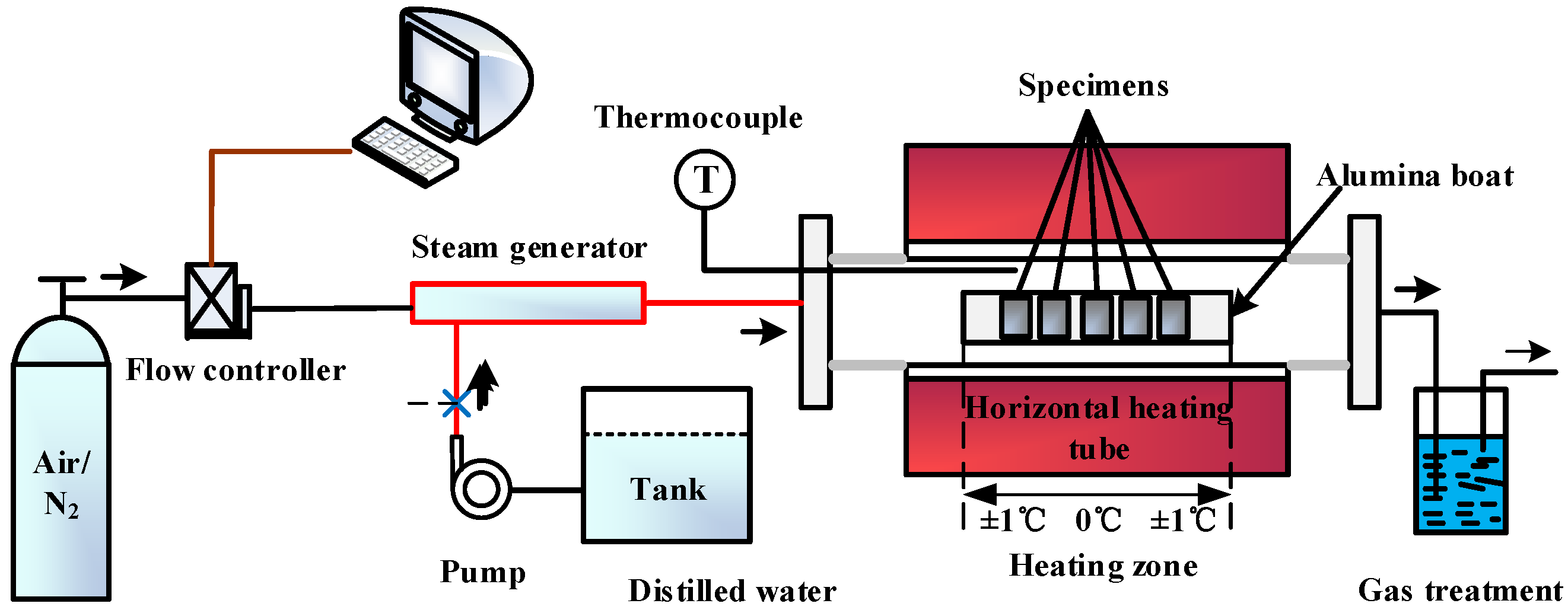
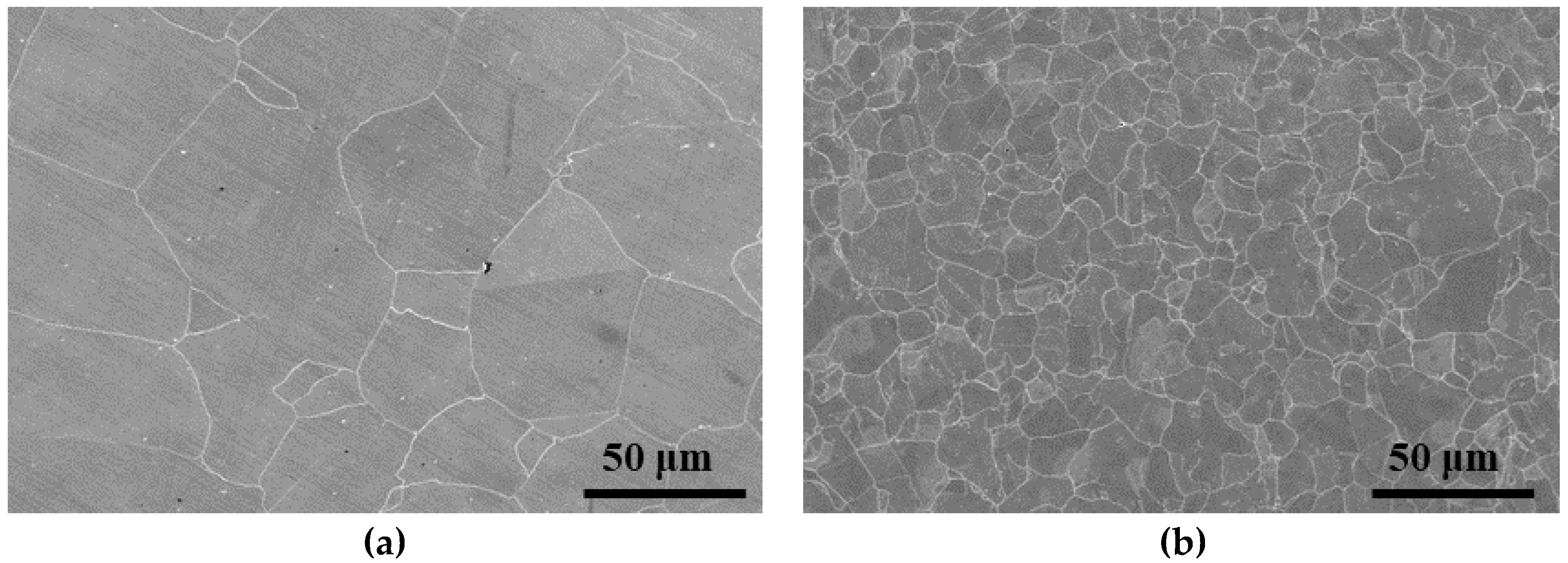
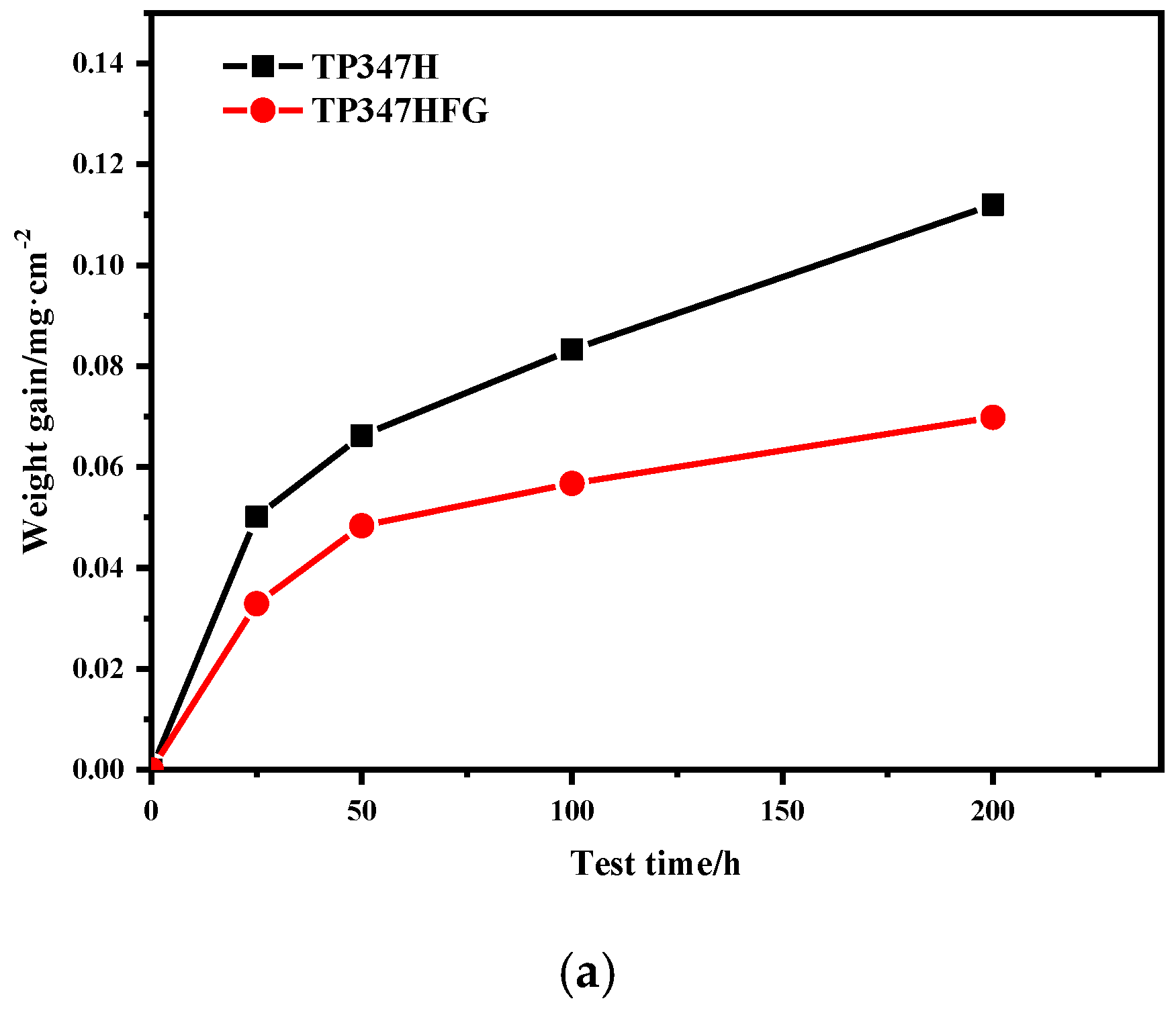

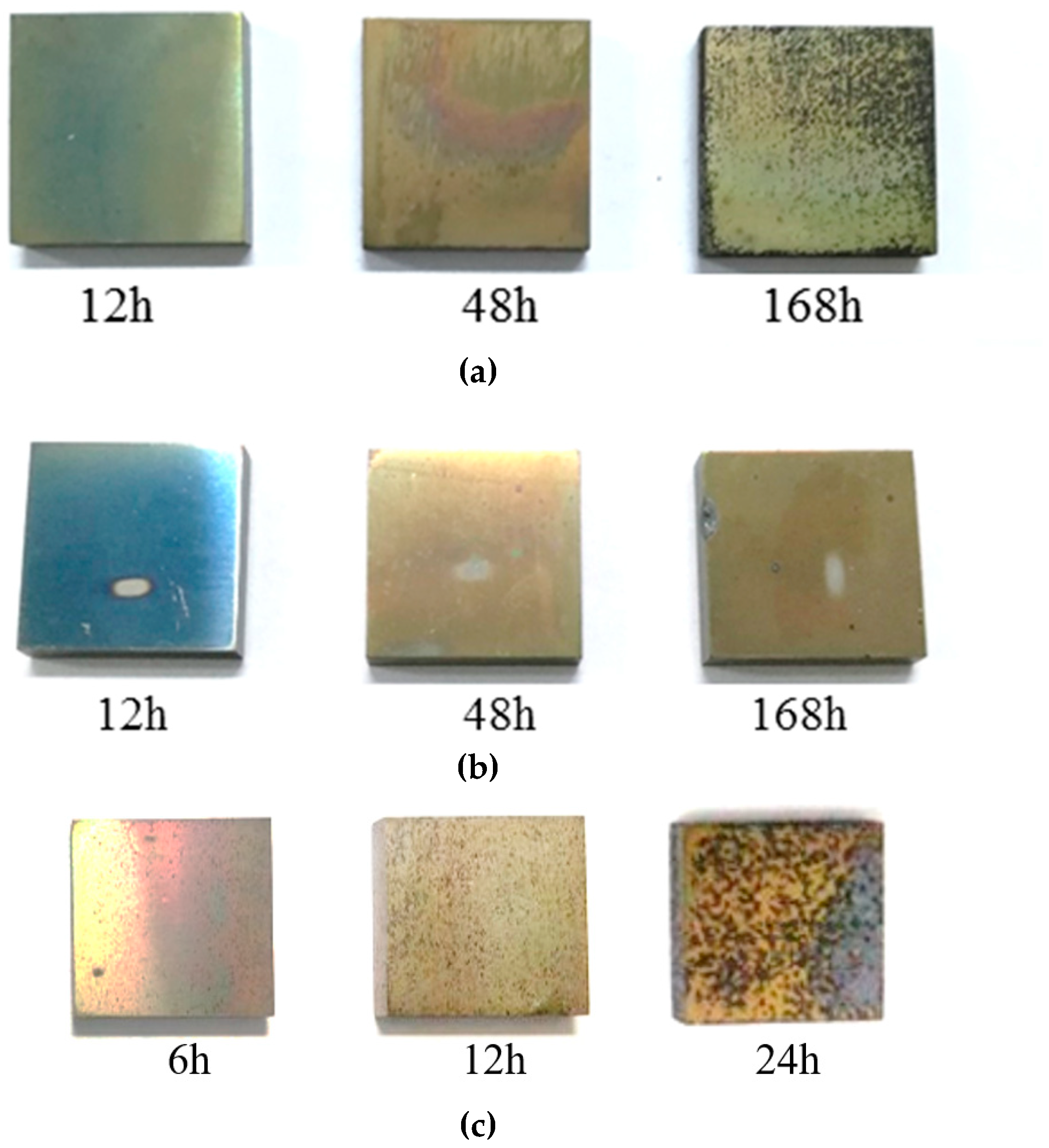


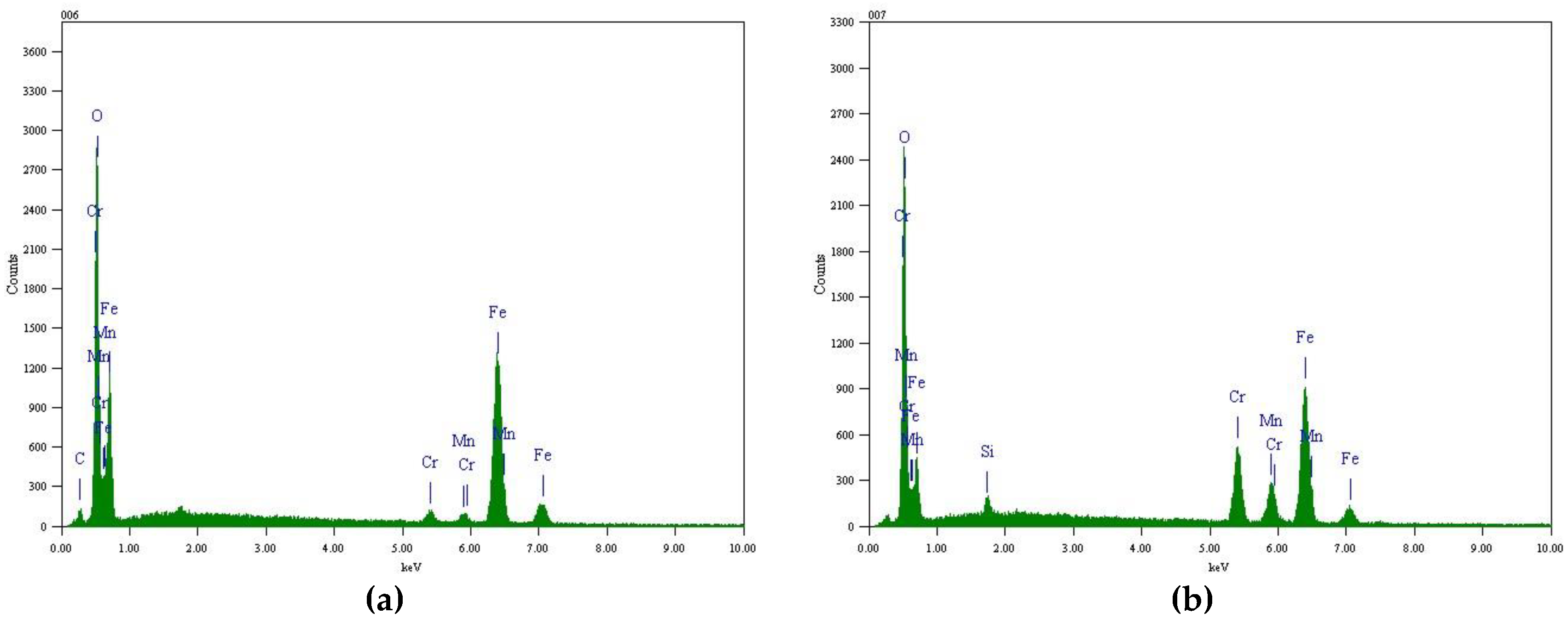



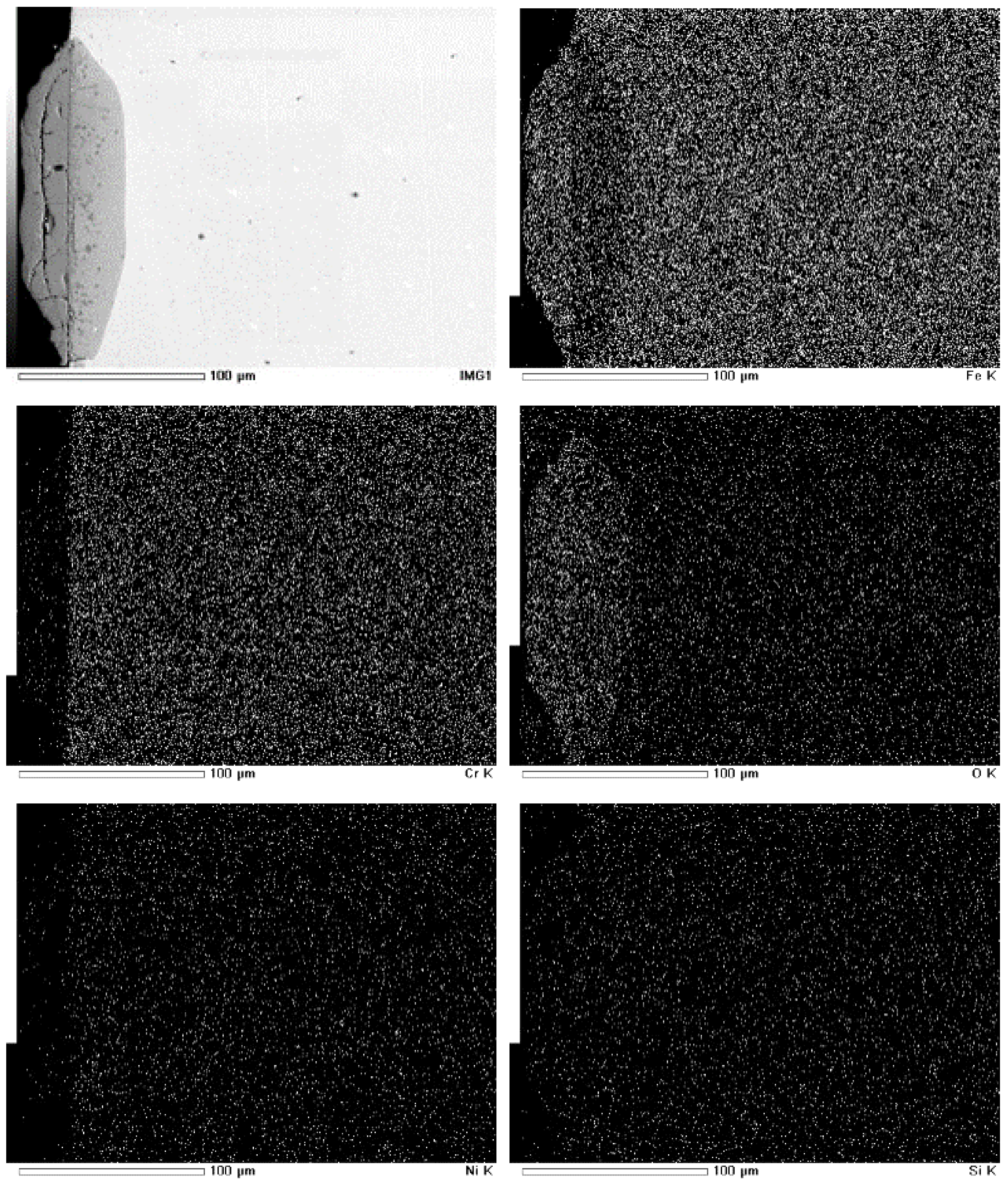
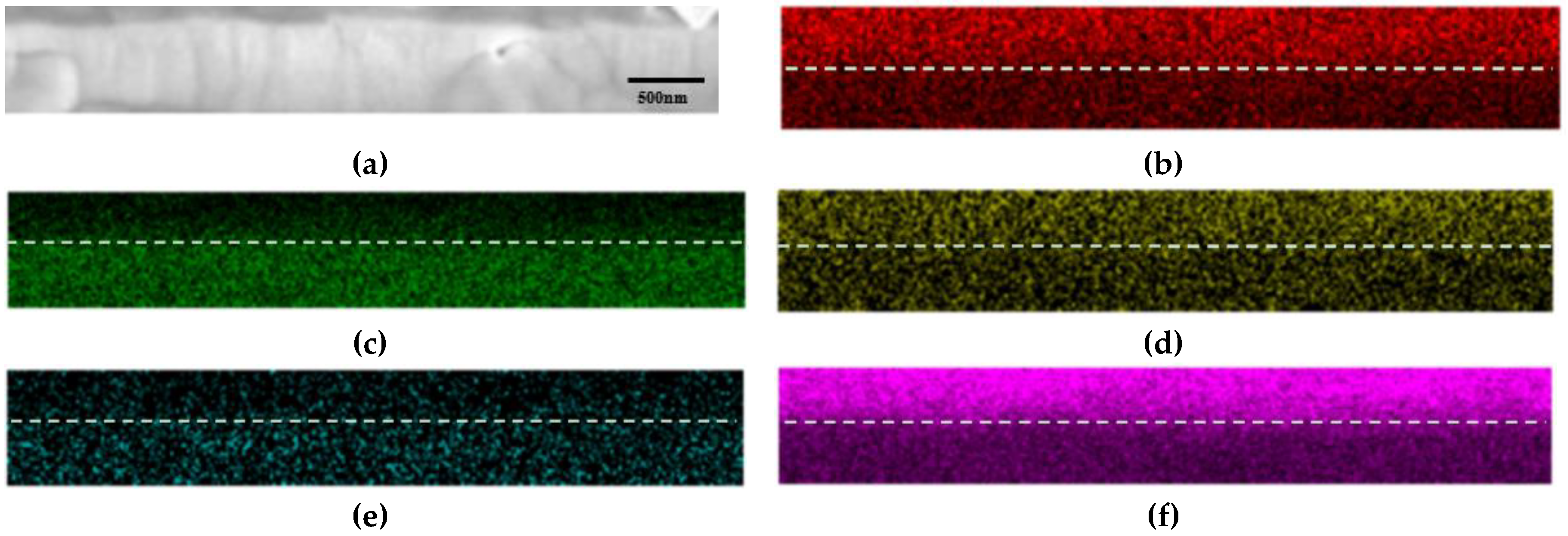
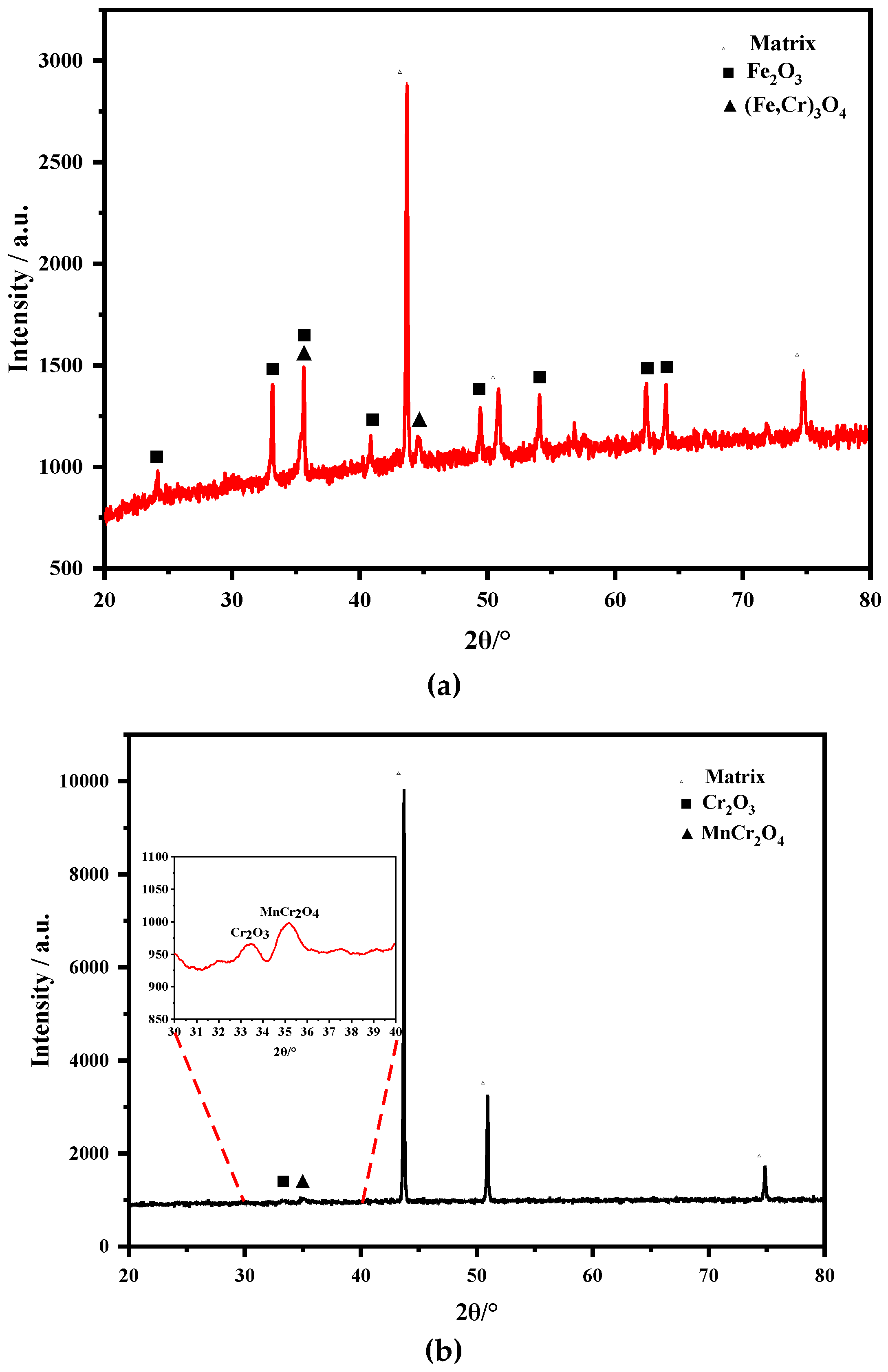
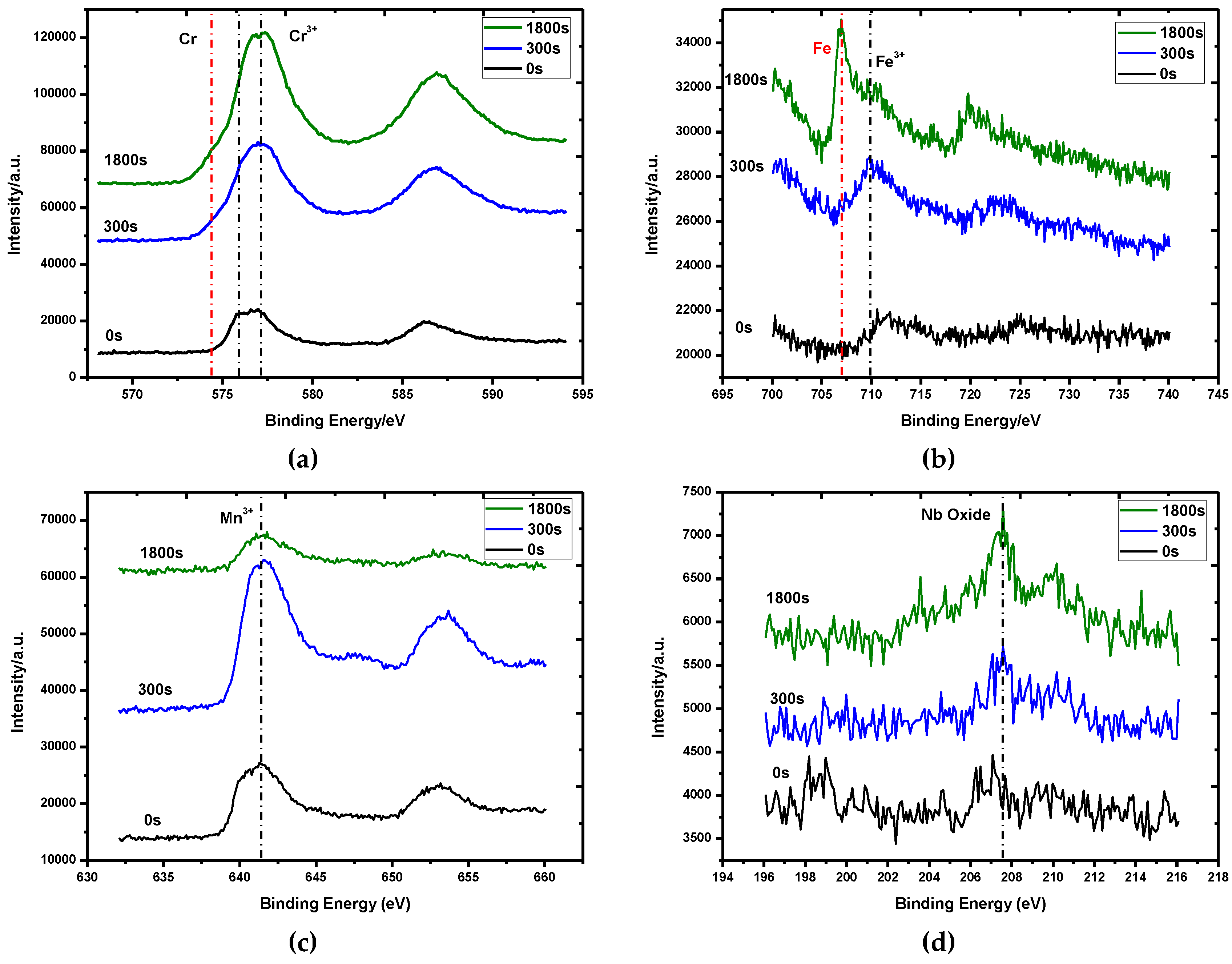
| Materials | C | Mn | Si | S | P | Cr | V | Ni | Cu | Nb |
|---|---|---|---|---|---|---|---|---|---|---|
| TP347H | 0.07 | 1.19 | 0.39 | 0.002 | 0.015 | 18.39 | <0.3 | 10.1 | <0.03 | 0.73 |
| TP347HFG | 0.08 | 0.75 | 0.48 | 0.002 | 0.020 | 18.31 | <0.1 | 10.7 | 0.05 | 0.73 |
| Materials | 650 °C | 700 °C | 800 °C |
|---|---|---|---|
| TP347H | Δm = 0.00796t0.5 | - | - |
| TP347HFG | Δm = 0.00526t0.5 | Δm = 0.00537t0.5 | Δm = 0.00595t0.5 |
| Content | Cr | Fe | O | Mn |
|---|---|---|---|---|
| No.01 | 34.53 | 22.68 | 33.73 | 4.45 |
| No.03 | 25.82 | 35.25 | 23.88 | 3.53 |
| Temperature (°C) | 650 | 700 | 800 |
|---|---|---|---|
| PCrO2(OH)2 (atm) | 1.4 × 10−11 | 4.0 × 10−11 | 4.0 × 10−10 |
© 2019 by the authors. Licensee MDPI, Basel, Switzerland. This article is an open access article distributed under the terms and conditions of the Creative Commons Attribution (CC BY) license (http://creativecommons.org/licenses/by/4.0/).
Share and Cite
Liang, Z.; Zhao, Q. Steam Oxidation of Austenitic Heat-Resistant Steels TP347H and TP347HFG at 650–800 °C. Materials 2019, 12, 577. https://doi.org/10.3390/ma12040577
Liang Z, Zhao Q. Steam Oxidation of Austenitic Heat-Resistant Steels TP347H and TP347HFG at 650–800 °C. Materials. 2019; 12(4):577. https://doi.org/10.3390/ma12040577
Chicago/Turabian StyleLiang, Zhiyuan, and Qinxin Zhao. 2019. "Steam Oxidation of Austenitic Heat-Resistant Steels TP347H and TP347HFG at 650–800 °C" Materials 12, no. 4: 577. https://doi.org/10.3390/ma12040577
APA StyleLiang, Z., & Zhao, Q. (2019). Steam Oxidation of Austenitic Heat-Resistant Steels TP347H and TP347HFG at 650–800 °C. Materials, 12(4), 577. https://doi.org/10.3390/ma12040577




